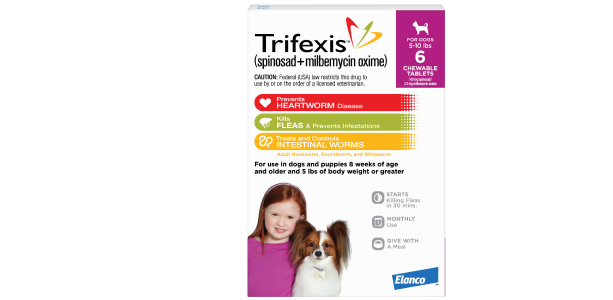Learn how to spot and treat fleas and worms.
We get it: Searching for flea and worm prevention for your dog can feel overwhelming. Options abound, from tablets to pills to topical treatments, as do the specific types of parasites they treat. So which one is right for your dog? Keep reading to learn about the signs of worms and fleas, treatment options, and preventive steps you can take to help keep your pet happy and healthy.
How to tell if your dog has worms
You probably know that all dogs are at risk for heartworm disease. But did you know there are also multiple intestinal worms in dogs you need to watch out for? Many dogs are at risk for exposure to these parasites in their normal daily activities, especially outdoors. Here’s how to spot the signs of worms in dogs.
Heartworms: Dogs get heartworms — long, string-like parasites that live in the heart and lungs — from mosquitoes. Signs may vary, and often, they don’t show up at all until the disease has progressed and caused serious complications. Indications of large numbers of heartworms may include coughing, fainting, erratic heartbeat, fatigue and difficulty breathing. Cardiopulmonary disease, heart failure and kidney disease may also develop as time passes.
Hookworms: These worms attach themselves to the lining of your pet’s intestine and feed on their blood. Your dog may pick them up by ingesting or walking on soil containing hookworm larvae or by eating an infected rodent. Signs include anemia, itchy paws, fatigue and difficulty breathing.
Roundworms: Dogs can pick up these long, white, spaghetti-like intestinal worms by eating soil that contains roundworm larvae or an infected rodent. Pregnant dogs infected with roundworms can also pass them on to their puppies. Adult dogs often show no symptoms, but puppies may be more affected, with signs including diarrhea, lethargy and poor coat condition.
Whipworms: These intestinal worms are so named because they look like whips, with a thick front end and a longer, thinner back end. They are most likely to infect dogs who like to dig in the dirt, thereby accidentally ingesting whipworm eggs that have leached into the soil from an infected animal’s feces. Mild infestations may cause no symptoms, but heavy infestations could cause bloody diarrhea, dehydration, weakness or weight loss.
How to tell if your dog has fleas
Fleas are the No. 1 skin parasite of dogs (and cats), and it’s very easy for your pet to pick them up on neighborhood walks, at the dog park or in your backyard. A friend or neighbor with a flea-infested pet could even inadvertently bring them into your home.
Fleas can be hard to spot with the naked eye, so it’s important to learn the signs:
- Excessive scratching, rubbing, biting or licking of the skin
- Missing patches of fur, a possible sign of flea allergy dermatitis
- Raised red or pink spots, an indication of flea bites
- Black specks in the fur, which could be flea droppings
- Small, dark, jumping insects about the size of a sesame seed
- Pale gums
- Nervousness, restlessness or other behavior changes
Homes with pets are especially at risk for a stubborn flea infestation, so taking the proper precautions before you see the signs can help avoid a long-term battle with these pests.
What’s the best worm treatment for dogs that also kills fleas?
Wondering how to treat hookworm in dogs or how to get rid of other intestinal worms? Are you trying to decide between an oral flea treatment, such as flea pills for dogs, or a topical treatment? Fortunately, products are available to treat and protect against multiple parasites.
Trifexis® (spinosad + milbemycin oxime) kills fleas and prevents reinfestations, prevents heartworm disease, and treats and controls three intestinal parasites: hookworm, roundworm and whipworm.
Trifexis® is a monthly beef-flavored tablet that’s approved for puppies and dogs 8 weeks and older and who weigh 5 pounds or more. It’s only available with a prescription, so ask your vet if Trifexis® is right for your dog.
Is it hard to get your dog to take pills? Another option is a topical flea and worm treatment, such as Advantage Multi® for dogs (imidacloprid + moxidectin). Ultimately, the best flea and worm treatment is the one your vet recommends for your dog.
How can I prevent fleas and worms in my dog?
When it comes to parasites, prevention is key for your pet and your family. Fleas can bite humans, too (although they don’t live on us as they do on animals), and people can contract hookworms (by walking barefoot over soil containing hookworm larvae) and roundworms (by accidentally swallowing eggs).
In addition to talking to your vet about the best flea and worm protection for your pet, take these steps to help reduce the risk of contracting parasites:
- Pick up dog waste as soon as possible and dispose of it properly.
- Wash your hands thoroughly after picking up waste or playing with dogs outside, and help children do the same.
- Wash your pet’s bedding often.
By focusing on prevention and knowing how to recognize the signs of worms and fleas in your dog, you can spend less time worrying about parasites — and more quality time with your pet.
Indications
Trifexis prevents heartworm disease. Trifexis kills fleas and prevents flea infestations, and treats and controls adult hookworm, roundworm and whipworm infections in dogs and puppies 8 weeks and older and 5 pounds or more.
Important Safety Information
The use of ivermectin at higher than FDA-approved doses at the same time as Trifexis can result in serious side effects. Treatment with fewer than three monthly doses after the last exposure to mosquitoes may not provide complete heartworm prevention. Prior to administration of Trifexis, dogs should be tested for existing heartworm infection. Use with caution in breeding females. The safe use of Trifexis in breeding males has not been evaluated. Use with caution in dogs with pre-existing epilepsy. The most common adverse reactions reported are vomiting, decreased activity, itching, decreased appetite, and diarrhea. To ensure heartworm prevention, observe your dog for one hour after administration. If vomiting occurs within an hour of administration, redose with another full dose. Puppies less than 14 weeks of age may experience a higher rate of vomiting. For complete safety information, please see Trifexis product label or ask your veterinarian. Like all medications, keep Trifexis out of the reach of children.

Trifexis® (spinosad + milbemycin oxime)
A beef-flavored tablet that kills fleas and prevents flea infestations, prevents heartworm disease, and treats and controls adult hookworm, roundworm and whipworm infections.










